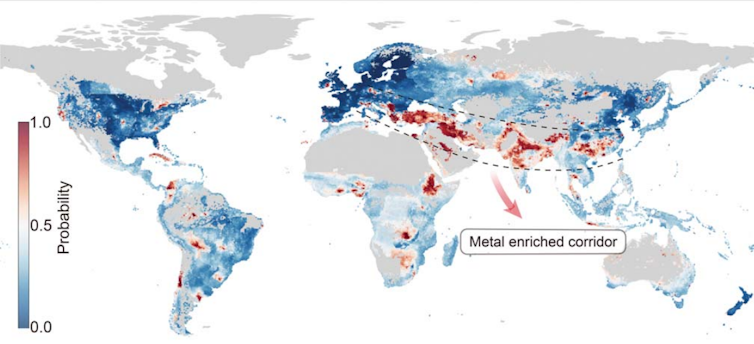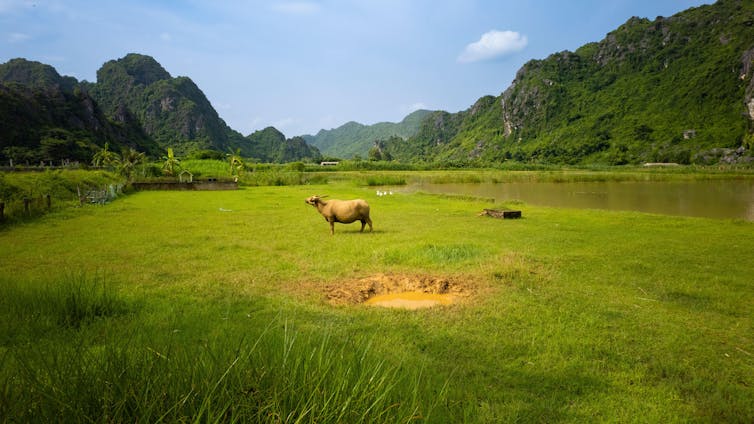
[ad_1]
Almost 17 % of the world’s crop lands are contaminated with “heavy metals”, according to a new study sciences. These pollutants – arsenic, cadmium, lead, and others – may be invisible to the eye, but threaten food safety and human health.
Heavy metals and minerals are elements that arise from natural or human sources. Called “heavy” Because it is physically dense and its weight is high on an atomic scale.
Heavy metals do not collapse. They remain in the soil for decades, where crops can absorb and enter the food chain. Over time, they accumulate in the body, causing chronic diseases that may take years to appear. This is not a problem for the distant future; It already affects the food that is grown today.
Some heavy metals, such as zinc and copper, are the basic microorganisms in the quantities of trace. Others – including arsenic, cadmium, mercury, and lead – are they Toxic Even with low concentrations.
Some of them are left by natural geology, while others by contracts of industrial and agricultural activities. They settle in the soil through mining, factory emissions, fertilizers or polluted water.
When crops grow, they paint nutrients from soil and water – sometimes, these pollutants as well. Rice, for example, is known for the introduction of arsenic from the fields flooded by water. Leafy vegetables can accumulate cadmium. These minerals do not change the taste or color of food. But they change what it does inside the body.
The quiet health crisis under our crops
Long -term exposure to Arsenicand CadmiumOr Lead It is linked to cancer, kidney damage, osteoporosis, and children’s growth disorders. In areas where local diets depend heavily on one basic crop, such as rice or wheat, risk multiplies.
the Scientific studyLed by Chinese scientist Deyi Hou and his colleagues, it is one of the most comprehensive maps efforts. By combining modern developments in machine learning and a wide range of data from 796,084 soil concentration of 1,493 studies, the authors evaluated global soil pollution systematically for seven toxic minerals: arsenic, cadmium, cobalt, chromium, copper, nickel, and bullets.
The study found that cadmium in agricultural soil has repeatedly exceeded the threshold, especially in the shaded areas of red in this map:

Hou et al / Science
Authors also describe a “enriched metal corridor” that extends from southern Europe across the Middle East and to South Asia. These are the areas where agricultural productivity overlaps with the history of mining, industrial activity and limited organization.
How does science read the story of the soil
Heavy metal pollution varies in crop lands by region, and is often formed by geology, land use date and water management. Through the center and southeast of Asia, the rice fields are irrigated with groundwater that naturally contain arsenic. The deposition of arsenic water in the soil, where it is eaten by rice.
Fortunately, nature often provides defense. Modern research Show that certain types of iron minerals in the soil can convert arsenic – a toxic shape, moving from arsenic – to arsenic, a less harmful type that is more tightly associated with iron minerals. The invisible soil chemistry represents a safety net.

Amazing / Islam
In parts of West Africa, such as Burkina Faso, the effect of arsenic pollution on drinking water and irrigation on crop lands. To address this, colleagues developed me Simple filtering system Using Zerovalent Iron – mainly, iron nails. These low -cost filters locally showed promising results in removing arsenic from groundwater.
In parts of South America, crop lands near small mines face additional risks. In the Amazon basin, the removal of forests and informal mining contributes to mercury issues. Forests act as natural mercury forests, and store mercury in the atmosphere in the biomass and soil. When wiping, this is a store Mercury is launched in the environmentRaising air levels and may affect nearby water bodies and agricultural lands.
Crops often suffer from old mining sites TechniquesThese sites can be treated and converted into chances of circular economics.
Evidence -based solutions
Soil pollution is not just a scientific issue. It is the issue of environmental justice. The most affected societies are the least responsible for pollution. They may grow on marginal lands near the industry, irrigation of unsafe water, or not reach the test and treatment. They face a dual burden: food insecurity, water, and toxic exposure.
There is no single repair. We will need a reliable evaluation of polluted soil and groundwater, especially in small holders. Reducing exposure requires cleaner agricultural inputs, improving irrigation, and better regulating old industrial sites. Equally important is to enable societies to access information and tools that enable them to grow safely.
The soil carries memory. They record every contaminant, every neglected list, every decision to cut off the corners. But the soil also carries the ability to recover – if the appropriate support is provided.
This is not about panic. It comes to responsibility. The scientific study provides a flagrant reminder, but in a timely manner that food safety does not start in the kitchen or market, but on the ground under our feet. No country should export toxicity that is not aware of its pills, and no farms should be left without tools for food transplantation safely.
